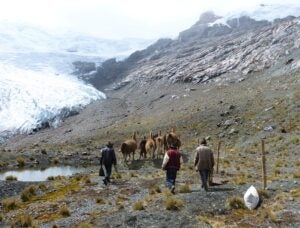Introducing llamas (Llama glama) into land exposed by retreating glaciers can speed the establishment of stable soils and ecosystem formation, mitigating some of the harmful effects of climate change, according to experimental research conducted by scientists at The University of Texas at Austin and partner institutions in Peru.
"Glaciers are melting rapidly around the world, creating unstable and dangerous landscapes, acid rock drainage, and land rushes for mining that are disrespecting local and Indigenous land rights," said Tim Beach, professor of geography and the environment and one of the paper's authors. "The research shows that llamas, when managed by Indigenous herders, are accelerating soil fertility and plant succession."
The study is published in Nature Scientific Reports.
Land exposed by glacial melting initially has low nutrient soil that is inhospitable to vegetation. Without intervention, these landscapes can take hundreds of years to stabilize.
The researchers partnered with the Llama 2000 Asociación, a local community of farmers whose village had been affected by acid rock drainage. Working at the exposed edge of the Uruashraju glacier in the Cordillera Blanca, Peru, the team created eight 925-square-meter plots, half of which would house llamas and half of which would remain unoccupied control plots. They then monitored soil quality and plant species prevalence in the plots from 2019 to 2022.

By the end of three years of observation, the llama plots showed significantly increased soil organic carbon and nitrogen levels and also a 57% increase in plant cover, with four plant species identified between the second and thirds years of the experiment that were not present at the start.
The increase in soil fertility on the llama plots can be attributed to the animals' dung, fur and grazing. The researchers also analyzed dung samples to see whether llamas could act as seed redistributors. They found 12 species of seeds among the dung, five of which still had germination capabilities, meaning that llamas could introduce plant species for lower elevations to recently deglaciated land.
As mountain glaciers continue to rapidly shrink in the wake of climate change, gathering data on the management of post-melt ecosystems is critical.
"No such experiment has been done like this in these areas, and at this altitude, though there have been grazing experiments with other types of grazing animals, and we know they can often be helpful for ecosystem management," said Anaïs Zimmer, a recent Ph.D. graduate from UT and first author on the paper. "The findings also have a high sociocultural impact since the llamas are part of ancestral herding practices. Andean camelid rewilding, in collaboration with local communities, might help to ameliorate the destructive processes of global warming-induced deglaciation while favoring the local economy."






